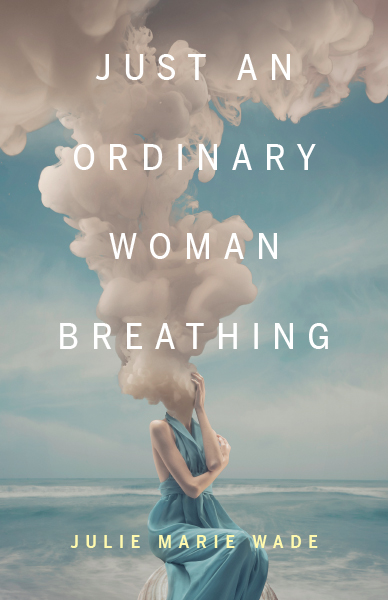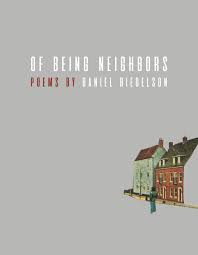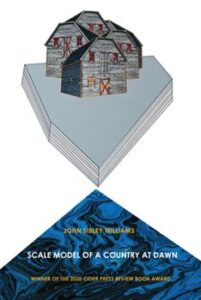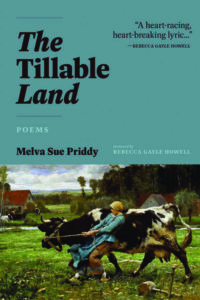Reviewed by Emily Jalloul // March 17, 2020
Mad Creek Books, 2020
Paperback, 208 pages, $18.95
“Just An Ordinary Woman Breathing” is Julie Marie Wade’s eleventh book. Her others, a mix of poetry, lyric-essay, and memoir, have garnered wide praise, including winning a Lambda Literary Award, among others prizes. The voice and lyricism that exists in her other collections is as powerful as it is clear, and if you have not read or heard of Julie Marie Wade before, you should know that her work examines and questions intersections and boundaries, and regularly blurs the line between poetry and prose, another border Wade enjoys investigating. Many of these themes are found within this book, as Wade explores the body, what it means to have or be a body; definitions and ideals of beauty, how beauty correlates to value; memory and history, what each individual history means. That is to say, it is a text that bridges a gap between lyricism and memoir, poetry and prose, and like most of Wade’s books, can be difficult to describe succinctly. Structurally, the book is divided into five parts, and each is further broken into smaller sections. Section one is divided into two, “overture” and “encore,” and opens the book with the revelatory statement, “Dangerous the epiphany that you are old enough to have a history. This is a danger like no other, except perhaps the danger of the primeval epiphany: You have a body. Have? Are?” From here, the book blends Wade’s own familial histories and memories with deep meditations on what it means to be beautiful and how the body impacts fate and choice, while weaving her own narrative with elements of pop-culture, literature, religion, and even math. While non-linear in organization, the book serves as a bildungsroman, showing us Wade as a child and as an adult, through a series of different angles. Wade is someone who believes in the supreme power of words and their ability to be “embodied”; she is a true lover of language, and from an early age, we see her exploring what it means to create words and how their meanings evoke different effects: “My father isn’t interested in language the way I am. Words are all function for him—like pointing a finger at something you want, a gesture made by the tongue. But for me they are form, they are sound, they are sacred somehow. They have colors and textures, even flavors sometimes, or a fragrance once in a while. Words, for me, are embodied, and like anything that has (is) a body, a word can be beautiful, or graceful, or ugly in a way that makes you wish you could close your ears.” In this powerful anecdote, Wade is speaking not as an adult author, but as a child who understands the capacity of language beyond descriptions; she sees that “language is like skin: there are layers to it….” Through these meditations on language and beauty, Wade examines gender and sexuality, recalling a crush she developed on a camp counselor or the imaginary “sister” she fabricates then falls in love with. She illustrates how complicated it is as a young girl in a conservative, religious household to find not only privacy but acceptance. Wade is careful, clever, and balanced in the characterizations of her mother, portraying a troubled and complicated woman, who suffers from her own problems of gender that she desperately attempts to place on her daughter. In one moment, Wade’s childhood diary is discovered and her mother is “scandalized” by Wade’s fantasies of her camp counselor and imagined “sister”; her mother claims that it“casts the entire family in negative light.” In another, her mother scolds her for questioning why a woman has to have sex with her husband if she doesn’t want to. Throughout all of these problematic and difficult sequences, however, Wade employs humor in a way that I can say from knowing her personally is natural her to voice. This is perhaps one of the most difficult balances to strike, discussing and analyzing deep metaphorical and literal issues with the body and gender, without weighing down the reader or appearing to demand sympathy. Wade is self-aware and objective. She is conscious of the way that words give her confidence and a sense of superiority she otherwise lacks, like when her family goes skiing and her younger cousin is a natural on the slopes while Wade struggles: “Blythe is a year younger, and her vocabulary is not as advanced as mine. In language, I have reached the double black diamond.” Other times, the humor appears so ordinary, it feels accidental in the way that children can sometimes stumble upon something funny without meaning to, like when a friend asks Wade if her mother is a “hippie,” and Wade replies, “No, she’s a Republican.” Additionally, the balance of personal narrative and outside voices is created by weaving in aspects of pop culture, from Marylin Monroe to Shirley Temple to White Christmas. Through the lens of a child, looking at these hugely famous aspects of American culture, Wade illustrates how ideas of beauty impact value and become concrete in young minds. She and her cousins are watching White Christmas as an “educational film. It is the film where we learn to become critics, where we learn to dissect women’s bodies the way we will dissect frogs and fetal pigs in high school biology class.” The fourth and fifth parts of the book respectively question religion and thread together all the themes of the book in a final chapter, ultimately attempting to answer some unsolvable question through mathematics-inspired formulas that Wade creates: “Let H be the set of all natural numbers for which H (n<1) specifies women and H (n>1) specifies men.” She asks why any of this matters, and once again her mother’s beliefs on gender are used to represent a voice of society, not just her mother: “There are things a woman must do, if she discovers a deficit or an excess in her body.” The book slowly builds toward a place of self-acceptance and love, through the use of deep interrogations on society’s long-held beliefs regarding the bodies of men and women, love, gender, sexuality, family, and religion. It does this, in typical Wade-fashion, without verging on sentimentality or saccharine positivity. Instead, Wade guides the reader through her own conscious realization of what it means to be complete. Rather than telling us what she feels, she questions her own feelings and ultimately allows us to discover the answers along with her.
That is to say, it is a text that bridges a gap between lyricism and memoir, poetry and prose, and like most of Wade’s books, can be difficult to describe succinctly. Structurally, the book is divided into five parts, and each is further broken into smaller sections. Section one is divided into two, “overture” and “encore,” and opens the book with the revelatory statement, “Dangerous the epiphany that you are old enough to have a history. This is a danger like no other, except perhaps the danger of the primeval epiphany: You have a body. Have? Are?” From here, the book blends Wade’s own familial histories and memories with deep meditations on what it means to be beautiful and how the body impacts fate and choice, while weaving her own narrative with elements of pop-culture, literature, religion, and even math. While non-linear in organization, the book serves as a bildungsroman, showing us Wade as a child and as an adult, through a series of different angles.
Wade is someone who believes in the supreme power of words and their ability to be “embodied”; she is a true lover of language, and from an early age, we see her exploring what it means to create words and how their meanings evoke different effects: “My father isn’t interested in language the way I am. Words are all function for him—like pointing a finger at something you want, a gesture made by the tongue. But for me they are form, they are sound, they are sacred somehow. They have colors and textures, even flavors sometimes, or a fragrance once in a while. Words, for me, are embodied, and like anything that has (is) a body, a word can be beautiful, or graceful, or ugly in a way that makes you wish you could close your ears.” In this powerful anecdote, Wade is speaking not as an adult author, but as a child who understands the capacity of language beyond descriptions; she sees that “language is like skin: there are layers to it….”
Through these meditations on language and beauty, Wade examines gender and sexuality, recalling a crush she developed on a camp counselor or the imaginary “sister” she fabricates then falls in love with. She illustrates how complicated it is as a young girl in a conservative, religious household to find not only privacy but acceptance. Wade is careful, clever, and balanced in the characterizations of her mother, portraying a troubled and complicated woman, who suffers from her own problems of gender that she desperately attempts to place on her daughter. In one moment, Wade’s childhood diary is discovered and her mother is “scandalized” by Wade’s fantasies of her camp counselor and imagined “sister”; her mother claims that it“casts the entire family in negative light.” In another, her mother scolds her for questioning why a woman has to have sex with her husband if she doesn’t want to.
Throughout all of these problematic and difficult sequences, however, Wade employs humor in a way that I can say from knowing her personally is natural her to voice. This is perhaps one of the most difficult balances to strike, discussing and analyzing deep metaphorical and literal issues with the body and gender, without weighing down the reader or appearing to demand sympathy. Wade is self-aware and objective. She is conscious of the way that words give her confidence and a sense of superiority she otherwise lacks, like when her family goes skiing and her younger cousin is a natural on the slopes while Wade struggles: “Blythe is a year younger, and her vocabulary is not as advanced as mine. In language, I have reached the double black diamond.” Other times, the humor appears so ordinary, it feels accidental in the way that children can sometimes stumble upon something funny without meaning to, like when a friend asks Wade if her mother is a “hippie,” and Wade replies, “No, she’s a Republican.”
Additionally, the balance of personal narrative and outside voices is created by weaving in aspects of pop culture, from Marylin Monroe to Shirley Temple to White Christmas. Through the lens of a child, looking at these hugely famous aspects of American culture, Wade illustrates how ideas of beauty impact value and become concrete in young minds. She and her cousins are watching White Christmas as an “educational film. It is the film where we learn to become critics, where we learn to dissect women’s bodies the way we will dissect frogs and fetal pigs in high school biology class.”
The fourth and fifth parts of the book respectively question religion and thread together all the themes of the book in a final chapter, ultimately attempting to answer some unsolvable question through mathematics-inspired formulas that Wade creates: “Let H be the set of all natural numbers for which H (n<1) specifies women and H (n>1) specifies men.” She asks why any of this matters, and once again her mother’s beliefs on gender are used to represent a voice of society, not just her mother: “There are things a woman must do, if she discovers a deficit or an excess in her body.” The book slowly builds toward a place of self-acceptance and love, through the use of deep interrogations on society’s long-held beliefs regarding the bodies of men and women, love, gender, sexuality, family, and religion. It does this, in typical Wade-fashion, without verging on sentimentality or saccharine positivity. Instead, Wade guides the reader through her own conscious realization of what it means to be complete. Rather than telling us what she feels, she questions her own feelings and ultimately allows us to discover the answers along with her.
ABOUT THE AUTHOR
Julie Marie Wade is the author of nine collections of poetry and prose, including Same-Sexy Marriage (A Midsummer Night’s Press, 2018), SIX (Red Hen Press, 2016), Catechism: A Love Story (Noctuary Press, 2016), When I Was Straight (A Midsummer Night’s Press, 2014), Postage Due (White Pine Press, 2013), Small Fires (Sarabande Books, 2011), and Wishbone: A Memoir in Fractures (Bywater Books, 2014; Colgate University Press, 2010). A recipient of the Lambda Literary Award for Lesbian Memoir and grants from the Kentucky Arts Council and the Barbara Deming Memorial Fund, Wade teaches in the creative writing program at Florida International University and reviews regularly for Lambda Literary Review and The Rumpus. In 2019, Noctuary Press published her first co-authored collection with Denise Duhamel, The Unrhymables: Collaborations in Prose.






